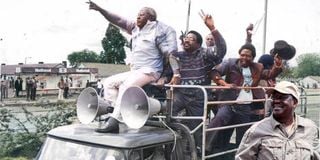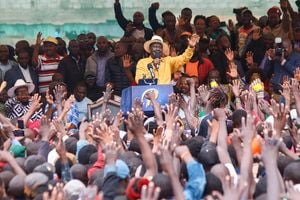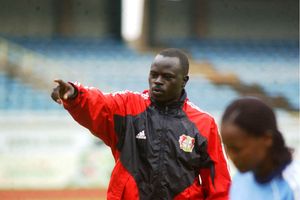
Opposition leaders heading to Kamukunji Grounds July 7, 1990. (inset) Azimio leader Raila Odinga.
Though they weren’t born during the July 7, 1990, Saba Saba uprising, Generation Z have recently demonstrated that fighting against an oppressive state requires continuous vigilance. By confronting the State, Gen Z has utilised the Saba Saba spirit of the 1990s to challenge the status quo. Ironically, Gen Zs’ uprising is directed at President William Ruto, who once aligned with anti-democratic forces to undermine the opposition in the 1990s via the notorious Youth for Kanu ‘92, led by Cyrus Jirongo.
Youth for Kanu 92 sought to rally then-youthful Generation X to support Moi’s dictatorship and deflate the emerging opposition. That YK’92 used money to corrupt the electoral system is now widely known. That they engineered political realignments and defections is well documented. Today, Ruto, a political student of the late President Moi, is facing a similar youthful rebellion at the helm of the State.
History is repeating itself
On July 7, 1990, a wave of outrage swept across Kenya as the Moi government attempted to suppress a public rally called by political trailblazers Kenneth Matiba and Charles Rubia at Kamukunji Stadium in Nairobi. The nation was ignited, driven by a genuine demand for multiparty democracy. In recent weeks, President Ruto has faced an open revolt after his MPs pushed through Parliament a controversial Finance Bill against public opinion that the proposed taxes would increase the cost of living.
While Ruto blamed the uprising on “criminals”, President Moi, on his part, blamed the pro-democracy uprising on “hooligans and drug addicts”. The most significant thing is that the 1990 riots dismantled the Western perception of Kenya as a bastion of political stability and the narrative of cohesiveness within single-party regimes. The uprising also challenged the Western government, which baby-sat President Moi as he grew political horns and created his version of a democratic state.
On the other hand, the Gen Z Uprising erased President Ruto’s international stature, and police violently dispersed the youth. It was the first time that Ruto, who had built his image as a dependable African leader, had faced a nationwide revolt. While President Moi had ordered a crackdown on the pro-democracy leaders, President Ruto opted for the kidnaps of some of the suspected organisers of the Gen Z revolt. More so, according to human rights groups, a few were shot after the processions. It was a script that the Ruto regime had borrowed from the Kanu days.

Thousands of Ford supporters attend a rally at the Kamukunji grounds on 18 January 1992. The party's first-ever licensed rally was much more than a rally, it was a festival.
In the 1990s, the Moi government had hoped that the July 4 detention of Matiba and Rubia would prevent the rally. However, on the day of the event, thousands of determined Nairobi residents forced their way into Kamukunji Stadium, sparking widespread riots in Nairobi, Kisumu, Nakuru, and previously politically quiet towns such as Nyeri, Thika, and Kiambu. Pro-democracy supporters, flashing the outlawed two-finger salute, demanded the release of all political detainees and a return to multiparty democracy. The unrest resulted in the deaths of more than 30 people, although some human rights organisations estimate the toll to be over 100.
Saba Saba, as the day became known, epitomised the spirit of defiance and symbolised Kenyans' collective resistance against an oppressive state, much like the contemporary Gen Z Uprising. But it was the 1990 deaths that jolted the international community, which now pressured the Moi regime to adopt change. While established politicians led the Saba Saba rally, the Gen Z Uprising surprised President William Ruto's regime after operating under the misguided belief that everything was under control. Additionally, despite widespread outcry, MPs who had pledged to pass the Finance Bill 2024 had vastly underestimated the depth of national anger.
This week, some goons appeared in the streets – and caused mayhem in various towns in a bid to damage the Gen Z reputation. The use of goons was not something new. In the 1990s, goons were used to either smear human faeces on opposition vehicles or attack their families. On June 13, a few days after Matiba's detention, some goons were sent to his house in Tigoni, where they attacked the family and injured Matiba’s wife, Edith – as part of State-sponsored thuggery.
With or without a permit
The Gen Z uprising was against some conservative MPs. The same had happened in 1990, when Kanu MPs opposed the introduction of multiparty democracy, arguing that Kenya was not yet ready. President Moi had dismissed Matiba and Rubia as “tribalists and puppets of foreign masters” – a standard tag used by Kanu adherents to denigrate the opposition. For instance, Kanu’s then-Organising Secretary Kalonzo Musyoka told the multiparty crusaders that “external forces must never dictate national interests”. He said the activists, “Kenya is a national sovereign State, a fact which is not negotiable and which cannot be compromised at any cost.” It was within that context that the Saba Saba rally was being held. A period of political chest-thumping when Kanu was, at best, arrogant and, at worst, dictatorial.

Kenneth Matiba (left) and Charles Rubia.
The Finance Bill 2024 uprising also happened within the context of highhandedness, in which the Ruto regime failed to read the writings on the wall. Gen Z decided to face the defiant MPs. In 1990, Matiba defiantly declared he would proceed with the proposed rally “with or without a permit”. At the time, the political opposition in Kenya was a coalition of diverse social forces united in their demand for good governance and the restoration of the rule of law. This coalition included clergy members, women's groups, human rights activists, journalists, and other professionals. The opposition had been emboldened by the changes in Eastern Europe, where single-party dictatorships had collapsed. They had accused the ruling Kanu of election rigging, corruption, and intolerance.
As Matiba and Rubia tested the limits of freedom of assembly, publications such as Gitobu Imanyara's Nairobi Law Monthly, Njehu Gatabaki’s Finance, and Pius Nyamora’s Society tested the boundaries of freedom of expression. Today, Gen Z has various media platforms that make it easier to address their issues.
The 1990 detentions and subsequent riots marked a pivotal moment in Kenya's struggle for multiparty democracy. Historians assert that this period exposed the extent of public discontent with Kanu and created new symbols of resistance. Various personalities had emerged to symbolise this discontent. Names such as Paul Muite, Raila Odinga, John Khaminwa, Martha Karua, and professional opposition figures such as Oginga Odinga, Masinde Muliro, and Martin Shikuku re-emerged and found new voices that articulated the new world order.
Gen Zs starting without any organised platform is familiar. A year after the 1990 Saba Saba riots, a framework emerged for Kenya's opposition. It was not until August 1991 that the pro-democracy agitators formed the Forum for the Restoration of Democracy (FORD), whose founder members were Martin Shikuku, Oginga Odinga, Ahmed Bahmariz, Phillip Gachoka, George Nthenge, and Masinde Muliro. This group, operating within the confines of law, would become the fulcrum of opposition politics.
Ford was vociferous. At a time when most of the leading lights of opposition politics were silenced behind bars, it continued to pressure the Moi government to abandon the single-party dictatorship. The churches also became a platform for change, with Bishop Henry Okullu, Manasses Kuria, and Rev Timothy Njoya becoming some of the radical voices. They also called for free elections and the resignation of the government.
But Moi had repeatedly promised to hunt down political pluralists "like rats" - the same threats that are emanating from the State to frighten those demanding change. By categorising the opposition activities as "subversive", the Moi government had demonised any alternative thoughts and created an avenue for crackdown. Subsequently, the one-party regime broadened its crackdown on proponents of multiparty democracy in one the harshest crackdowns since 1982 following the aborted coup.
The Directorate of Criminal Investigations (DCI) has also published names of those thought to have participated in “criminal” activities. These include looters caught on camera breaking into private properties. Pro-democracy supporters also found comfort in Western embassies, including those of the US, the Scandinavians, and even Great Britain. The US Ambassador Smith Hempstone became a significant figure in the push for reforms.
While it is too early to see how Gen Z will organise their politics, what is clear is that they have started a conversation that neither Ruto nor his disciples can stop. In the meantime, like in the 1990s, some outfits similar to YK92 are beginning to emerge and utilising the State House connections to bring together the youth. Like in the 1990s, Ruto’s daughter organised such a forum this week. For those familiar with the workings of YK 92, history is once again repeating itself.










